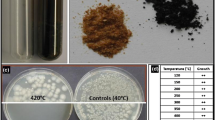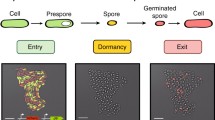Abstract
In terms of resistance to extreme environmental stresses, the bacterial spore represents a pinnacle of evolution. Spores are highly resistant to a wide variety of physical stresses such as: wet and dry heat, UV and gamma radiation, oxidizing agents, chemicals, and extremes of both vacuum and ultrahigh hydrostatic pressure. Some of the molecular mechanisms underlying spore resistance properties have been elucidated in the laboratory, and involve both: (i) protection of vital spore macromolecules during dormancy, and (ii) repair of damaged macromolecules during germination. Our group has recently become interested in testing if the laboratory model of spore UV resistance is relevant to spore persistence in the environment. We have constructed a number of Bacillus subtilis strains which are defective in various DNA repair systems and spore structural components. Using spores of these strains, we have been exploring: (i) the types of damage induced in DNA by the UV-B and UV-A components of sunlight; (ii) the relative contribution of the major spore DNA repair systems to spore solar radiation resistance; and (iii) the role of spore structural components such as the spore coats and dipicolinic acid (DPA) in attenuation of the lethal and mutagenic effects of solar UV. The current data are reviewed with the ultimate goal of obtaining a complete model describing spore persistence and longevity in the terrestrial solar UV radiation environment.
Similar content being viewed by others
References
Donnellan JE Jr & Setlow RB (1965) Thymine photoproducts but not thymine dimers are found in ultraviolet irradiated bacterial spores. Science 149: 308-310.
Driks A (1999) Bacillus subtilis spore coat. Microbiol. Mol. Biol. Rev. 63: 1-20.
Fajardo-Cavazos P & Nicholson (1995) Molecular dissection of mutations in the Bacillus subtilis spore photoproduct lyase gene which affect repair of spore DNA damage caused by UV radiation. J. Bacteriol. 177: 4402-4409.
Fajardo-Cavazos P, Salazar C & Nicholson WL (1993) Molecular cloning and characterization of the Bacillus subtilis spore photoproduct lyase (spl) gene, which is involved in repair of UV-induced DNA damage during spore germination. J. Bacteriol. 175: 1735-1744.
Friedberg EC, Walker GC & Siede W (1995) DNA repair and mutagenesis. American Society for Microbiology, Washington, DC.
Hullo M-F, Moszer I, Danchin A & Martin-Verstraete I (2001) CotA of Bacillus subtilis is a copper-dependent laccase. J. Bacteriol. 183: 5426-5430.
Lindberg C & Horneck G (1991) Action spectra for survival and spore photoproduct formation of Bacillus subtilis irradiated with short wavelength (200-300 nm) UV at atmospheric pressure and in vacuo. J. Photochem. Photobiol. B Biol.11:69-80.
Lindsay JA & Murrell WG (1983) A comparison of UV-induced DNA photoproducts from isolated and non-isolated bacterial forespores. Biochem. Biophys. Res. Commun. 113: 618-625.
Munakata N & Rupert CS (1975) Effects of DNA-polymerase-defective and recombination-deficient mutations on the ultraviolet sensitivity of Bacillus subtilis spores. Mutat. Res. 27: 157-169.
Nicholson WL, Chooback L & Fajardo-Cavazos (1997) Analysis of spore photoproduct lyase operon (splAB) function using targeted deletion-insertion mutations spanning the Bacillus subtilis operons ptsHI and splAB. Mol. Gen. Genet. 255: 587-594.
Nicholson WL & Fajardo-Cavazos P (1997) DNA repair and the ultraviolet radiation resistance of bacterial spores: from the laboratory to the environment. Recent Res. Devel. Microbiol. 1: 125-140.
Nicholson WL, Munakata N, Horneck G, Melosh HJ & Setlow P (2000) Resistance of Bacillus endospores to extreme terrestrial and extraterrestrial environments. Microbiol. Molec. Biol. Rev. 64: 548-572.
Nicholson WL & Setlow (1990) Sporulation, germination, and outgrowth. In: Harwood CR & Cutting SM (Eds) Molecular Biological Methods for Bacillus (pp 391-450). John Wiley and Sons, Sussex, UK.
Paidhungat M, Setlow B, Driks A & Setlow P (2000) Characterization of spores of Bacillus subtilis which lack dipicolinic acid. J. Bacteriol. 182: 5505-5512.
Riesenman PJ & Nicholson WL (2000) Role of the spore coat layers in Bacillus subtilis resistance to hydrogen peroxide, artificial UVC, UV-B, and solar radiation. Appl. Environ. Microbiol. 66: 620-626.
Schaeffer P, Millet J & Aubert JP (1965) Catabolic repression of bacterial sporulation. Proc. Natl. Acad. Sci. USA 54:704-711.
Setlow P (1995) Mechanisms for the prevention of damage to DNA in spores of Bacillus species. Annu. Rev. Microbiol. 49:29-54.
Setlow P (2001) Resistance of spores of Bacillus species to ultraviolet light. Environ. Mol. Mutagen. 38: 97-104.
Slieman TA & Nicholson WL (2000) Artificial and solar UV radiation induces strand breaks and cyclobutane pyrimidine dimers in Bacillus subtilis spore DNA. Appl. Environ. Microbiol. 66: 199-205.
Slieman TA & Nicholson WL (2001) Role of dipicolinic acid in survival of Bacillus subtilis spores exposed to artificial and solar UV radiation. Appl. Environ. Microbiol. 67: 1274-1279.
Somerville HJ, Delafield FP & Rittenberg SC (1970) Ureamercaptoethanol-soluble protein from spores of Bacillus thuringiensis and other species. J. Bacteriol. 101: 551-560.
Spizizen J (1958) Transformation of biochemically deficient strains of Bacillus subtilis by deoxyribonucleate. Proc. Natl. Acad. Sci. USA 44: 548-572.
Tanooka H (1968) Ultraviolet resistance of DNA in spore spheroplast of Bacillus subtilis as measured by the transforming activity. Biochim. Biophys. Acta 166: 581-583.
Tanooka H & Sakakibara Y (1968) Radioresistant nature of the transforming activity in bacterial spores. Appl. Microbiol. 26: 592-597.
Tyrrell RM (1978) Solar dosimetry with repair deficient bacterial spores: action spectra, photoproduct measurements and a comparison with other biological systems. Photochem. Photobiol. 27: 571-579.
Tyrrell RM (1992) Inducible responses to UV-A exposure. In: Urbach F (Ed) Biological Responses to Ultraviolet-A Radiation (pp 59-64). Valdenmar Publishing, Overland Park, Kansas.
Xue Y (1996) Resistance of Bacillus subtilis spores lacking either nucleotide excision repair or spore photoproduct lyase to ultraviolet (UV) radiation from artificial or natural sources. Thesis (Master of Science), University of North Texas Health Science Center.
Xue Y & Nicholson WL (1996) The two major spore DNA repair pathways, nucleotide excision repair and spore photoproduct lyase, are sufficient for the resistance of Bacillus subtilis spores to artificial UV-C and UV-B but not to solar radiation. Appl. Environ. Microbiol. 62: 2221-2227.
Author information
Authors and Affiliations
Corresponding author
Rights and permissions
About this article
Cite this article
Nicholson, W.L., Fajardo-Cavazos, P., Rebeil, R. et al. Bacterial endospores and their significance in stress resistance. Antonie Van Leeuwenhoek 81, 27–32 (2002). https://doi.org/10.1023/A:1020561122764
Issue Date:
DOI: https://doi.org/10.1023/A:1020561122764




